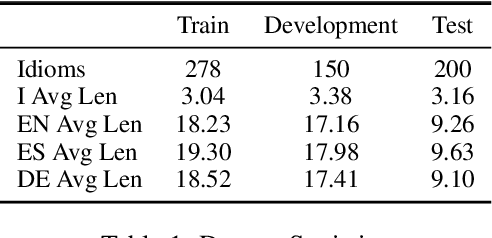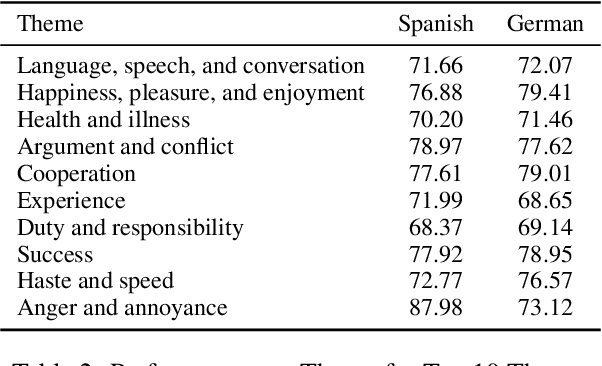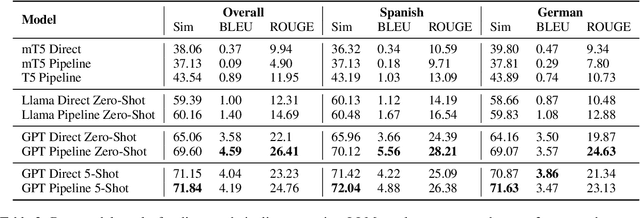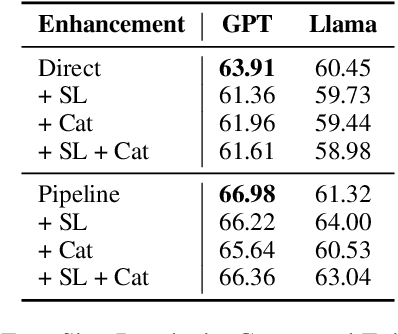Katharina von der Wense
JGU Mainz's Submission to the WMT25 Shared Task on LLMs with Limited Resources for Slavic Languages: MT and QA
Sep 26, 2025Abstract:This paper presents the JGU Mainz submission to the WMT25 Shared Task on LLMs with Limited Resources for Slavic Languages: Machine Translation and Question Answering, focusing on Ukrainian, Upper Sorbian, and Lower Sorbian. For each language, we jointly fine-tune a Qwen2.5-3B-Instruct model for both tasks with parameter-efficient finetuning. Our pipeline integrates additional translation and multiple-choice question answering (QA) data. For Ukrainian QA, we further use retrieval-augmented generation. We also apply ensembling for QA in Upper and Lower Sorbian. Experiments show that our models outperform the baseline on both tasks.
Mind the Gap: A Closer Look at Tokenization for Multiple-Choice Question Answering with LLMs
Sep 18, 2025Abstract:When evaluating large language models (LLMs) with multiple-choice question answering (MCQA), it is common to end the prompt with the string "Answer:" to facilitate automated answer extraction via next-token probabilities. However, there is no consensus on how to tokenize the space following the colon, often overlooked as a trivial choice. In this paper, we uncover accuracy differences of up to 11% due to this (seemingly irrelevant) tokenization variation as well as reshuffled model rankings, raising concerns about the reliability of LLM comparisons in prior work. Surprisingly, we are able to recommend one specific strategy -- tokenizing the space together with the answer letter -- as we observe consistent and statistically significant performance improvements. Additionally, it improves model calibration, enhancing the reliability of the model's confidence estimates. Our findings underscore the importance of careful evaluation design and highlight the need for standardized, transparent evaluation protocols to ensure reliable and comparable results.
Large Language Models Discriminate Against Speakers of German Dialects
Sep 17, 2025Abstract:Dialects represent a significant component of human culture and are found across all regions of the world. In Germany, more than 40% of the population speaks a regional dialect (Adler and Hansen, 2022). However, despite cultural importance, individuals speaking dialects often face negative societal stereotypes. We examine whether such stereotypes are mirrored by large language models (LLMs). We draw on the sociolinguistic literature on dialect perception to analyze traits commonly associated with dialect speakers. Based on these traits, we assess the dialect naming bias and dialect usage bias expressed by LLMs in two tasks: an association task and a decision task. To assess a model's dialect usage bias, we construct a novel evaluation corpus that pairs sentences from seven regional German dialects (e.g., Alemannic and Bavarian) with their standard German counterparts. We find that: (1) in the association task, all evaluated LLMs exhibit significant dialect naming and dialect usage bias against German dialect speakers, reflected in negative adjective associations; (2) all models reproduce these dialect naming and dialect usage biases in their decision making; and (3) contrary to prior work showing minimal bias with explicit demographic mentions, we find that explicitly labeling linguistic demographics--German dialect speakers--amplifies bias more than implicit cues like dialect usage.
Improving Low-Resource Morphological Inflection via Self-Supervised Objectives
Jun 05, 2025Abstract:Self-supervised objectives have driven major advances in NLP by leveraging large-scale unlabeled data, but such resources are scarce for many of the world's languages. Surprisingly, they have not been explored much for character-level tasks, where smaller amounts of data have the potential to be beneficial. We investigate the effectiveness of self-supervised auxiliary tasks for morphological inflection -- a character-level task highly relevant for language documentation -- in extremely low-resource settings, training encoder-decoder transformers for 19 languages and 13 auxiliary objectives. Autoencoding yields the best performance when unlabeled data is very limited, while character masked language modeling (CMLM) becomes more effective as data availability increases. Though objectives with stronger inductive biases influence model predictions intuitively, they rarely outperform standard CMLM. However, sampling masks based on known morpheme boundaries consistently improves performance, highlighting a promising direction for low-resource morphological modeling.
Implicitly Aligning Humans and Autonomous Agents through Shared Task Abstractions
May 07, 2025Abstract:In collaborative tasks, autonomous agents fall short of humans in their capability to quickly adapt to new and unfamiliar teammates. We posit that a limiting factor for zero-shot coordination is the lack of shared task abstractions, a mechanism humans rely on to implicitly align with teammates. To address this gap, we introduce HA$^2$: Hierarchical Ad Hoc Agents, a framework leveraging hierarchical reinforcement learning to mimic the structured approach humans use in collaboration. We evaluate HA$^2$ in the Overcooked environment, demonstrating statistically significant improvement over existing baselines when paired with both unseen agents and humans, providing better resilience to environmental shifts, and outperforming all state-of-the-art methods.
Untangling the Influence of Typology, Data and Model Architecture on Ranking Transfer Languages for Cross-Lingual POS Tagging
Mar 25, 2025Abstract:Cross-lingual transfer learning is an invaluable tool for overcoming data scarcity, yet selecting a suitable transfer language remains a challenge. The precise roles of linguistic typology, training data, and model architecture in transfer language choice are not fully understood. We take a holistic approach, examining how both dataset-specific and fine-grained typological features influence transfer language selection for part-of-speech tagging, considering two different sources for morphosyntactic features. While previous work examines these dynamics in the context of bilingual biLSTMS, we extend our analysis to a more modern transfer learning pipeline: zero-shot prediction with pretrained multilingual models. We train a series of transfer language ranking systems and examine how different feature inputs influence ranker performance across architectures. Word overlap, type-token ratio, and genealogical distance emerge as top features across all architectures. Our findings reveal that a combination of typological and dataset-dependent features leads to the best rankings, and that good performance can be obtained with either feature group on its own.
Corrective In-Context Learning: Evaluating Self-Correction in Large Language Models
Mar 20, 2025Abstract:In-context learning (ICL) has transformed the use of large language models (LLMs) for NLP tasks, enabling few-shot learning by conditioning on labeled examples without finetuning. Despite its effectiveness, ICL is prone to errors, especially for challenging examples. With the goal of improving the performance of ICL, we propose corrective in-context learning (CICL), an approach that incorporates a model's incorrect predictions alongside ground truth corrections into the prompt, aiming to enhance classification accuracy through self-correction. However, contrary to our hypothesis, extensive experiments on text classification tasks demonstrate that CICL consistently underperforms standard ICL, with performance degrading as the proportion of corrections in the prompt increases. Our findings indicate that CICL introduces confusion by disrupting the model's task understanding, rather than refining its predictions. Additionally, we observe that presenting harder examples in standard ICL does not improve performance, suggesting that example difficulty alone may not be a reliable criterion for effective selection. By presenting these negative results, we provide important insights into the limitations of self-corrective mechanisms in LLMs and offer directions for future research.
CLIX: Cross-Lingual Explanations of Idiomatic Expressions
Jan 06, 2025



Abstract:Automated definition generation systems have been proposed to support vocabulary expansion for language learners. The main barrier to the success of these systems is that learners often struggle to understand definitions due to the presence of potentially unfamiliar words and grammar, particularly when non-standard language is involved. To address these challenges, we propose CLIX, the task of Cross-Lingual explanations of Idiomatic eXpressions. We explore the capabilities of current NLP models for this task, and observe that while it remains challenging, large language models show promise. Finally, we perform a detailed error analysis to highlight the key challenges that need to be addressed before we can reliably incorporate these systems into educational tools.
Measuring Contextual Informativeness in Child-Directed Text
Dec 23, 2024Abstract:To address an important gap in creating children's stories for vocabulary enrichment, we investigate the automatic evaluation of how well stories convey the semantics of target vocabulary words, a task with substantial implications for generating educational content. We motivate this task, which we call measuring contextual informativeness in children's stories, and provide a formal task definition as well as a dataset for the task. We further propose a method for automating the task using a large language model (LLM). Our experiments show that our approach reaches a Spearman correlation of 0.4983 with human judgments of informativeness, while the strongest baseline only obtains a correlation of 0.3534. An additional analysis shows that the LLM-based approach is able to generalize to measuring contextual informativeness in adult-directed text, on which it also outperforms all baselines.
Lost in the Middle, and In-Between: Enhancing Language Models' Ability to Reason Over Long Contexts in Multi-Hop QA
Dec 13, 2024



Abstract:Previous work finds that recent long-context language models fail to make equal use of information in the middle of their inputs, preferring pieces of information located at the tail ends which creates an undue bias in situations where we would like models to be equally capable of using different parts of the input. Thus far, the problem has mainly only been considered in settings with single pieces of critical information, leading us to question what happens when multiple necessary pieces of information are spread out over the inputs. Here, we demonstrate the effects of the "lost in the middle" problem in the multi-hop question answering setting -- in which multiple reasoning "hops" over disconnected documents are required -- and show that performance degrades not only with respect to the distance of information from the edges of the context, but also between pieces of information. Additionally, we experiment with means of alleviating the problem by reducing superfluous document contents through knowledge graph triple extraction and summarization, and prompting models to reason more thoroughly using chain-of-thought prompting.
 Add to Chrome
Add to Chrome Add to Firefox
Add to Firefox Add to Edge
Add to Edge